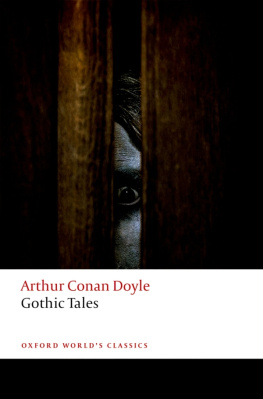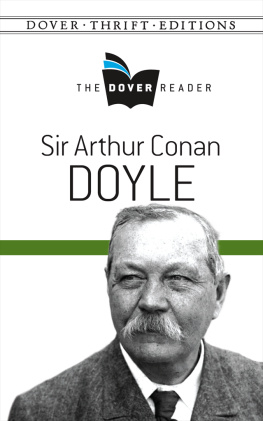Arthur Conan Doyle - Sherlock Holmes: Illustrated and Complete
Here you can read online Arthur Conan Doyle - Sherlock Holmes: Illustrated and Complete full text of the book (entire story) in english for free. Download pdf and epub, get meaning, cover and reviews about this ebook. year: 2011, publisher: The Seashell Press, genre: Detective and thriller. Description of the work, (preface) as well as reviews are available. Best literature library LitArk.com created for fans of good reading and offers a wide selection of genres:
Romance novel
Science fiction
Adventure
Detective
Science
History
Home and family
Prose
Art
Politics
Computer
Non-fiction
Religion
Business
Children
Humor
Choose a favorite category and find really read worthwhile books. Enjoy immersion in the world of imagination, feel the emotions of the characters or learn something new for yourself, make an fascinating discovery.
- Book:Sherlock Holmes: Illustrated and Complete
- Author:
- Publisher:The Seashell Press
- Genre:
- Year:2011
- Rating:5 / 5
- Favourites:Add to favourites
- Your mark:
- 100
- 1
- 2
- 3
- 4
- 5
Sherlock Holmes: Illustrated and Complete: summary, description and annotation
We offer to read an annotation, description, summary or preface (depends on what the author of the book "Sherlock Holmes: Illustrated and Complete" wrote himself). If you haven't found the necessary information about the book — write in the comments, we will try to find it.
Sherlock Holmes: Illustrated and Complete — read online for free the complete book (whole text) full work
Below is the text of the book, divided by pages. System saving the place of the last page read, allows you to conveniently read the book "Sherlock Holmes: Illustrated and Complete" online for free, without having to search again every time where you left off. Put a bookmark, and you can go to the page where you finished reading at any time.
Font size:
Interval:
Bookmark:

For Jim Sheets
International Private Investigator
Sherlock Holmes: Illustrated and Complete, Copyright 2011 by The Seashell Press. All rights reserved. No part of this book may be used or reproduced in any manner whatsoever without written permission except in the case of brief quotations embodied in critical articles or reviews.
This is the Kindle edition of Sherlock Holmes: Illustrated and Complete, Release 1.02, May 2011. Corrections, comments and suggestions are welcome and may be sent to The Seashell Press at: mailbag@theseashellpress.com.
mailbag@theseashellpress.com.
Readers whose suggestions and corrections are incorporated in the next release of this book will receive a refund of their purchase and a free copy of the corrected edition. Thank you for your detecting.
Cover art is by Sidney Paget, colored by L.M. Goode of the Goode Press. From their publication "The Final Problem". (http://www.artintheblood.com)









In 1891, Sherlock Holmes was a character very much of his time and place, who appealed to British readers directly by confronting the messy, changeable world they lived in. Rather than dwelling in romance or in an idealized past, as many of Arthur Conan Doyle's other characters did, Holmes was grounded squarely in Victorian London. The Sherlock Holmes mystery stories, written over a forty-year span from 1887 to 1927, represented the good, the bad, and the ugly of Victorian society: its ideals, its accomplishments, and its deepest fears.
Arthur Conan Doyle's birth year, 1859, fell 22 years into Queen Victoria's 64-year reign, a time of unparalleled growth and optimism for the British Empire. Resources and labor taken from colonies worldwide had made England prosper, and the time of serious independence struggles lay in the distant future. Business flourished, technology blossomed, and London grew at a great rate--from one million people to six in the space of a century--creating problems of urban overcrowding familiar to us today: poverty, homelessness, drug abuse, crime. While the great divide between rich and poor and the economic and human strain of maintaining the colonies exacerbated social problems that were as yet insoluble, Victorian Britons, led by Victoria's husband Albert, put their faith in technology and science. The contrasts and conundrums of this fascinating time provided Conan Doyle with the raw material and the backdrop for Sherlock Holmes: a man of science, undistracted by the gentler passions, who moved easily through the disquieting urban space, using his wits to solve its moral and practical dilemmas.
Physically, London could be a place of disturbing contrasts, a cosmopolitan city where the middle class drank tea in comfortable drawing rooms while epidemics of typhoid and cholera ravaged the squalid, overpopulated East End. The putrid Thames River, the city's main source of drinking water, despite the network of open sewers that dumped tons of waste into it daily, carried a reeking cloud of contagion to all levels of society as it meandered through the heart of the city. Since 1844, the government had struggled with various solutions to the sewage problem. In 1858, the year before Conan Doyle was born, the "Great Stink," caused by the unfortunate effects of a hot summer on a sluggish, polluted river, clotted with solid waste, drove thousands out of the city.

Father Thames introducing his offspring to the city of London, Punch 1853
After years of effort, engineer Joseph Bazalgette designed and supervised construction of a sewer system, completed in 1866, that drained sewage away from the Thames and used the ebbing tide to wash it out to sea. London's air was not much cleaner than its water. The burning of coal for heat and cooking caused the greasy yellow "London fog" that Holmes and Watson prowl about in:
In the third week of November, in the year 1895, a dense yellow fog settled down upon London. From the Monday to the Thursday I doubt whether it was ever possible from our windows in Baker Street to see the loom of the opposite houses.
from "The Bruce Partington Plans"
Watson does not exaggerate; in the worst London fogs, it was impossible to see past your nose.

Inhabitants of London had more to fear from their city than an unhealthy environment. Barely thirty years before Doyle's birth, London was a criminal's paradise. Whole areas of the city were "owned" by criminal groups, and honest citizens hardly dared to walk through certain neighborhoods at night, even armed. In 1829, the Metropolitan Police was founded by Home Secretary Sir Robert Peel (hence the nickname "Bobbies"). By Conan Doyle's birth in 1859, there were over 200 police constabulary units in England and Wales, under the jurisdiction of individual counties. As Conan Doyle represents them in the Sherlock Holmes stories, the constabularies were highly bureaucratized organizations that did things "by the book"; constables themselves tended to be seen as good-intentioned, but plodding, and not always successful. Luckily, unlike Inspectors Lestrade and Hopkins, Holmes's erstwhile colleagues, the Metropolitan Police was not actually forced to match wits with Holmes's brilliant nemesis, Moriarty, leader of the most insidious criminal syndicate in England.
In the Sherlock Holmes stories, at least, the idyllic-seeming English countryside holds its own dangers. In Victorian England, small towns were still structured on the feudal model that had prevailed for centuries. In general, a large manor house, such as Baskerville Hall, dominated its village. And although the village people no longer led their lives serving the master of the manor, a strict social hierarchy still dictated that the master was the community leader in more ways than one. The health or dysfunction of the family living in the manor house could determine the whole character of a village. Holmes and Watson pursue many mysteries in the countryside surrounding London, where criminals carry on their nefarious activities away from prying eyes. As Holmes remarks:
"It is my belief, Watson, founded upon my experience, that the lowest and vilest alleys in London do not present a more dreadful record of sin than does the smiling and beautiful countryside. The pressure of public opinion can do in the town what the law cannot accomplish. There is no lane so vile that the scream of a tortured child, or the thud of a drunkard's blow, does not beget sympathy and indignation among the neighbours, and then the whole machinery of justice is ever so close that a word of complaint can set it going, and there is but a step between the crime and the dock. But look at these lonely houses, each in its own fields, filled for the most part with poor ignorant folk who know little of the law. Think of the deeds of hellish cruelty, the hidden wickedness which may go on, year in, year out, in such places, and none the wiser."
Font size:
Interval:
Bookmark:
Similar books «Sherlock Holmes: Illustrated and Complete»
Look at similar books to Sherlock Holmes: Illustrated and Complete. We have selected literature similar in name and meaning in the hope of providing readers with more options to find new, interesting, not yet read works.
Discussion, reviews of the book Sherlock Holmes: Illustrated and Complete and just readers' own opinions. Leave your comments, write what you think about the work, its meaning or the main characters. Specify what exactly you liked and what you didn't like, and why you think so.












